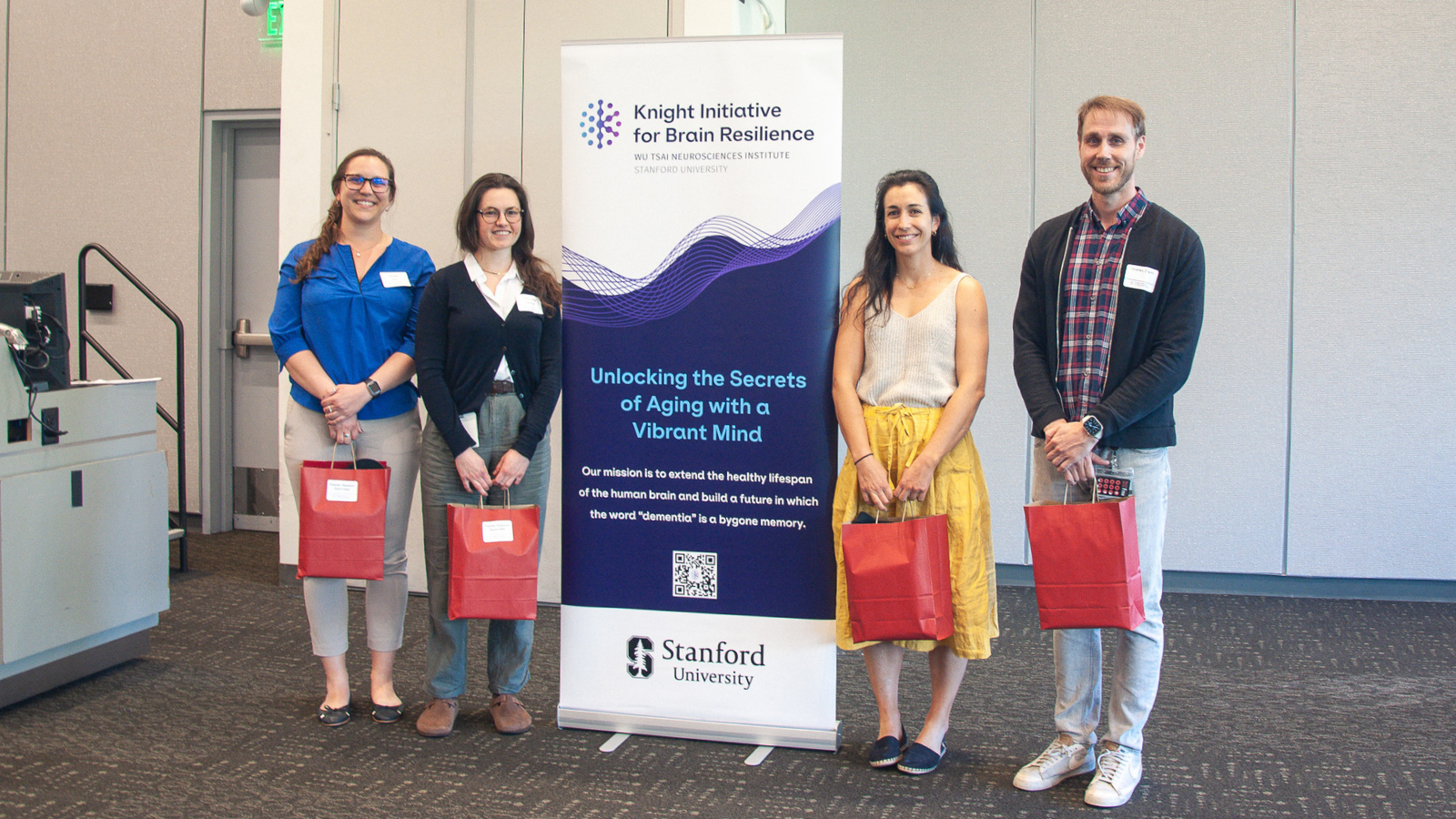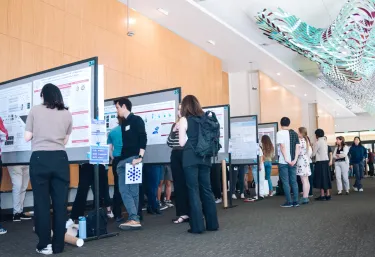
Marking the second anniversary of the Phil and Penny Knight Initiative for Brain Resilience, Initiative Director Tony Wyss-Coray stepped to the podium on May 23, 2024 to welcome attendees to a symposium showcasing a string of recent research advances flowing out of the Initiative’s grant programs, which support creative and bold approaches to study the biology of brain aging, health, and resilience.
Before launching into the first session of the day, Wyss-Coray paused to acknowledge the palpable energy and enthusiasm filling the room, as scientists from across the University and beyond prepared to hear the latest research. Most had attended that morning’s packed poster session, in which scores of researchers and trainees had crowded the foyer and conference hall, enthusiastically presenting nascent but promising research on a dizzying array of angles being taken to understand brain aging and combat neurodegenerative disease and cognitive decline.
Wyss-Coray then introduced the Symposium’s first session: not — as is now traditional at Knight Initiative Symposia — a case study of an ailing patient with a serious neurodegenerative condition, but a spotlight on a healthy patient with a resilient brain.
“Today we have a special treat. We have Harry [Tu] here, who is not suffering from a neurodegenerative disease. His brain is resilient. He is 90 years old and his cognition is perfectly fine,” said Wyss-Coray, who is D.H. Chen Professor of Neurology and Neurological Sciences.
The session was moderated by Elizabeth Mormino, an assistant professor of neurology who co-leads the Stanford Aging and Memory Study study (SAMS) in which Tu is a participant. The study, Mormino explained, is a longitudinal look at healthy older adults such as Tu that seeks to explain why some — but not others — retain remarkable mental acuity into their golden years. “Our memory is going to decline as we get older,” Mormino stated flatly. “But what's really remarkable is the variability. There’s a tremendous amount of variability across individuals. That’s what we are interested in.”
Interviewed gently by Mormino, Tu held forth about his nearly five decades in China before he emigrated to the U.S., about his family medical history, his facility with languages — English, Chinese, Russian, French, German and Japanese — his diet, his Sodoku and crossword puzzle habit, and his regular swimming and exercise regimen.
“My intention is to keep me both physically and mentally sharp,” Tu said. “Not to increase my strength or become Superman, but just to stay in shape.”
Tu received a resounding round of applause from the audience, many of whom seemed ready to take up Tu’s daily swimming regimen immediately.
Memory and aging
Mormino went on to present the latest results from the SAMS team, which she co-leads with psychology professor Anthony Wagner.
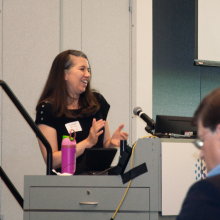
Mormino specifically studies memory loss due to the amyloid plaques and “tangles” of tau protein in the brain that are the biochemical signatures of Alzheimer’s Disease (AD).
In a decade-long study of a group of older adults with a range of cognitive abilities, she is exploring this variability in brian resilience. Mormino uses functional MRI (fMRI) to measure how memory is encoded in the brain and she cross-references this process against amyloid deposits and tau tangles — the biomarkers of Alzheimer’s Disease — to deliver new insights into mechanisms of memory resilience.
Surprisingly, she said, these biomarkers are also common in clinically unimpaired individuals — in resilient brains — suggesting that there is a threshold effect as amyloid plaque increases and tau tangles cascade from the medial temporal lobe — where they first emerge seemingly without consequence — to other parts of the brain, leading to cognitive impairment.
“It's not as simple as: if you have this early AD, you're going to decline. There's also mechanisms that may protect people even in the face of this pathological burden,” Mormino said.
So far, Mormino and colleagues have shown that there are multiple unexplored pathways to explain variation in memory performance. “The majority of the variance we can explain is beyond the classic AD pathway,” Mormino posited, hinting at a new direction in her research to illuminate what those other avenues might be.
Molecules and mechanisms
Next up was the first of two “lightning rounds” in which Knight-funded researchers quickly laid out promising early findings.
First, Jonathan Long, associate professor of pathology and an Institute Scholar of Sarafan ChEM-H (Chemistry, Engineering & Medicine for Human Health), described his studies of the beneficial effects of physical exercise on the healthy brain. He began by noting that those who get plenty of exercise also experience far less dementia, about 30% less in fact. Conversely, Long is intrigued by a lesser-known detail that physical inactivity can also lead to greater neurodegenerative disease.
Long studies what he calls “exerkines” – small molecules in the blood that are produced during exercise and appear to be beneficial to brain resilience. One in particular known as Lac-Phe (“lack fee”), Long described as the “most dramatically inducible” exerkine. It is produced only during sprinting, not in resistance or endurance exercises. Lac-Phe helps moderate metabolism and food intake, but is also important in memory and learning.
“We believe that Lac-Phe is a molecule that links sprint exercise to general brain function and brain health,” Long said. Long then tied Lac-Phe production to a specific gene, CNDP2. He plans, with support from his Innovation Award from the Knight Initiative, to look for other genes that might improve Lac-Phe production and to search for the molecular structures that Lac-Phe targets in the brain.
This knowledge, he said, could lead to the development of new therapeutics that leverage Lac-Phe to improve brain resilience.
Good and evil
Post-doctoral scholar Julia Belk, from the Pathology Department lab of Siddhartha Jaiswal, presented results from studies focused on microglia and a pre-leukemic process known as CHIP — clonal hematopoiesis of indeterminate potential.
Microglia are the brain’s immune cells, she said, but they can have both good and bad effects on the brain during aging. On the one hand, microglia can rid the brain of amyloid plaques implicated in Alzheimer’s Disease. On the other, they can also kill neurons.
“The classic question is: how can we decouple these good and bad functions?” Belk said. If the two faces of microglia in aging can be decoupled, it could provide an avenue to therapies to target the amyloid plaques.
She is part of a team that is supported by a Knight Initiative Innovation Award to study the impact of CHIP on brain aging and understand how peripheral immune cells immigrate and settle in the brain as “supplemental” microglia, apparently with a protective effect against Alzheimer’s disease in some cases. The team wants to understand how those cells differ from microglia that are produced during gestation, how they protect against neurodegeneration, and how these supplemental microglia infiltrate the brain in the first place.
“Is it possible that these cells could enter the brain in middle age or even younger and protect the aging brain against neurodegenerative disease?” Belk said, teasing the fundamental promise of her on-going research.
Pathologist Siddhartha Jaiswal and his team share their discovery that age-related mutations, which increase the risk of blood disease, also provide protection against brain disease. Credit: Devin Powell.
Energy embargo
Post-doctoral fellow Congcong Wang from the lab of Katrin Andreasson in the Department of Neurology stepped in to describe their Knight-supported collaboration studying how peripheral macrophages promote cognitive decline in older adults. Inflammation is a common thread in many age-related cognitive diseases, she said, and macrophages are the workhorses of immune defense. There are, by her estimate, 225 billion macrophages in the human body.
The Andreasson lab’s work hypothesizes that a decline in immune function over time is due to metabolic failure in the macrophages — they aren’t getting enough energy. The team has traced the problem to a byproduct of that metabolic process, pyruvate, which helps generate ATP that fuels the cells. They have shown that these metabolites decrease as we age, impairing macrophages’ function.
“Could we reverse the metabolic decline in the aging macrophages and restore the healthy immune functions for these cells?” Wang asked, noting that the lab’s research has shown that knocking out a single gene, EP2, appears to prevent this decline and that application of an EP2 inhibitor can similarly prevent cognitive decline in older mice.
New views on neurons

Next, in a keynote address, Mark Schnitzer, professor of biology and applied physics, explored promising new frontiers in brain imaging and its potential for studying the circuitry of neurodegenerative disorders like Parkinson's disease.
Schnitzer’s lab has engineered cutting edge optical tools — including a small, head-mounted microscopic camera — that enable high-resolution video recordings of neural activity and circuit dynamics in freely moving and behaving rodents. Schnitzer shared how his team is currently applying their tools to observe neural activity in a brain region called the basal ganglia — using high-resolution video to study how healthy, resilient neurons behave, and what’s going wrong when neural disorders like Parkinson’s strike.
Schnitzer presented three examples of his work. The first two compare the neural imbalances of motor disorders Parkinson’s and dyskinesia, which occupy opposite ends of the motor activity spectrum. Parkinson’s induces underactivity (hypoactivity) and dyskinesia lending to overactivation (hyperactivity) of certain basal ganglia neurons. A third avenue of Schnitzer’s work examines the altered coding of chronic pain.
Schnitzer then showed how he and colleagues have identified several “druggable” targets to treat these signature imbalances and are now testing four potential Parkinson’s drug candidates and several non-opioid analgesics that alleviate pain.
Future unfolding
The final hour of the symposium was reserved for a second lightning round summarizing work supported by Knight Initiative grants.
Judith Frydman, professor of biology and genetics and Donald Kennedy Chair in the School of Humanities and Sciences, described her lab’s research on proteostasis — the cellular biological pathways that mediate the creation, trafficking, and degradation of key proteins inside and outside a cell.
The intricate folding of long, complex proteins is critical to the proper functioning of all our bodies’ cells and systems. Reflecting the critical role of this process, our cells have developed equally complex mechanisms to ensure proteins are folded correctly and — if not — to rid the body of any ill-folded proteins.
Proteostasis declines sharply in later years, reducing the capacity of cells to maintain well-folded proteins. Frydman and collaborators theorize that age-related diseases such as Alzheimer’s, Parkinson’s, Huntington’s, ALS and others may be related to this failing process, adding that each of those diseases exhibit very similar misfolded proteins that increase risk for disease.
Using a specialized form of regenerative science, the team is creating Alzheimer’s neurons that retain key age-related characteristics to study the effects of time on neurons. Frydman and colleagues are using these aged cells to characterize the decline of proteostasis using advanced electron microscopy aided by high-throughput artificial intelligence. She’s now working with other researchers to understand these deficits in cell machinery and architecture.
As we age, neurons are subject to “a vicious circle,” she said. As proteostasis declines, cells accumulate damage, inducing stress, and begetting further damage, Frydman noted, pointing toward future avenues of research.
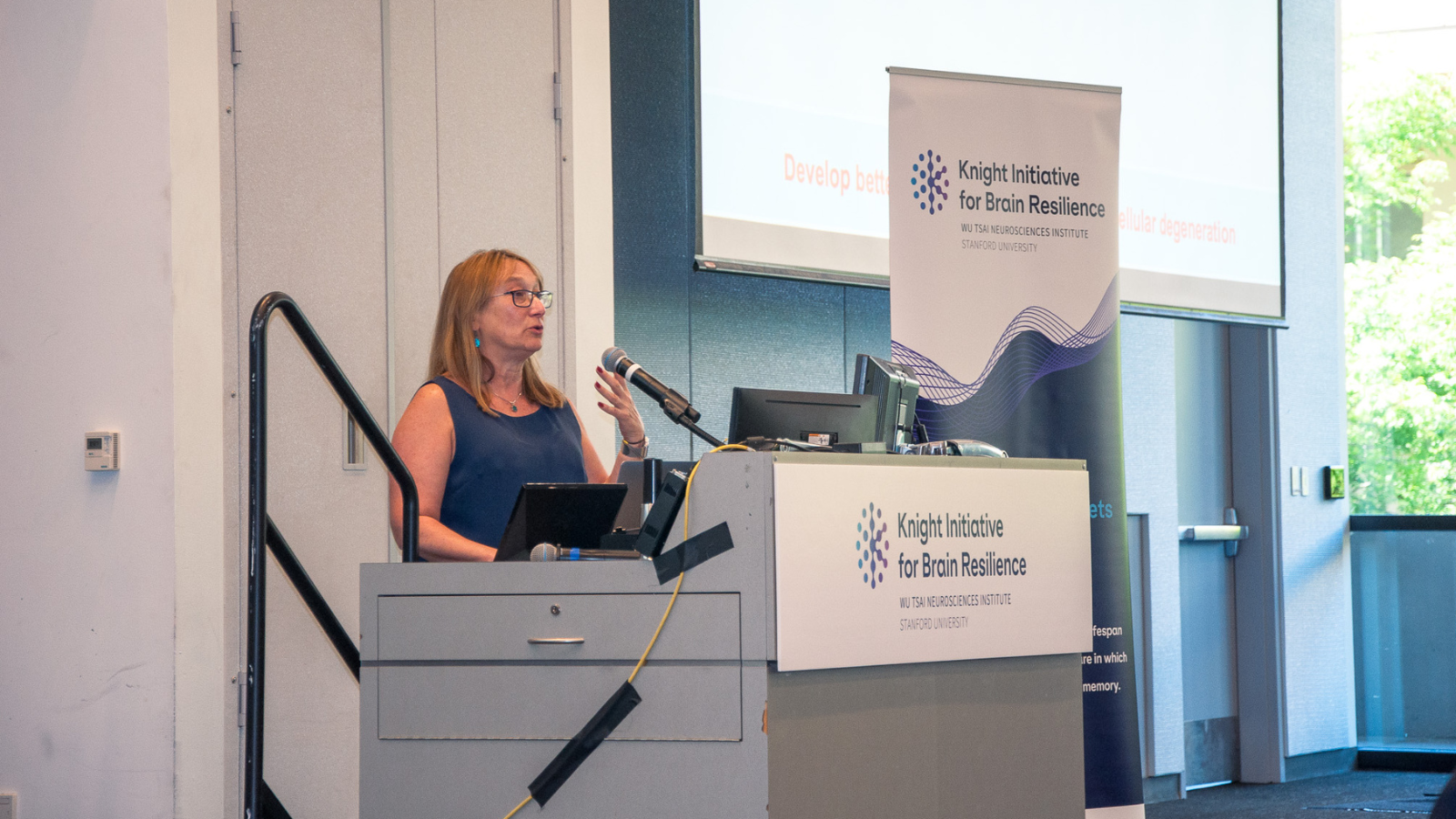
Cryptic messengers
Aaron Gitler, professor of genetics, then walked the audience through his team’s Knight Initiative–supported research on RNA binding protein TDP43, which regulates splicing during RNA metabolism. It is the key gene implicated in both frontotemporal dementia (FTD) and Amyotrophic Lateral Sclerosis (ALS/Lou Gehrig’s Disease). In aging, the immune system appears to undergo changes that cause it to attack healthy neurons in the brain, causing degeneration.
Gitler has been exploring the mechanisms that contribute to neurodegeneration associated with loss of a specific gene, TDP 43, he explained. One of TDP43’s primary roles is to repress aberrant miscoded genes — “cryptic exons” — created during RNA metabolism. Without TDP43, cryptic exons can destabilize messenger RNA (mRNA) leading to a number of genetic risk factors.
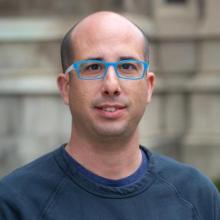
Gitler and collaborators combed through a catalog of cryptic exons and identified a particular gene — UNC13A — that they believe may be dysregulated when TDP43 goes awry. UNC13A just happens to be “one of the top GWAS hits for ALS and frontotemporal dementia,” Gitler noted.
“We now know exactly that this is caused by this cryptic exon being included, suggesting a therapeutic strategy … to block this cryptic exon splicing event,” Gitler detailed, dangling the notion that if the loss of TDP43 produces cryptic peptides, those peptides might activate T cells to attack the cells with those cryptic exons. The team is now pursuing the possibility of engineering T cells to target these pathways.
“We're very excited to all work together, not just discover peptides that might elicit these responses, but then deliver therapies using T cells,” Gitler said.
Quenching the fire
Finally, Anne Brunet, professor of genetics, took the stage to describe a Knight-supported collaboration with structural biologist Chris Garcia and microbiome expert Ami Bhatt that seeks to “quench inflammation” in the aging brain. The team studies a regenerative region of the brain known as the subventricular zone.
“We're excited about this because it contains neural stem cells that have the capacity to give rise to new cells in the adult brain,” Brunet said, suggesting that these regenerative capabilities could potentially be used to replace aging neurons.
She is focusing on the anti-inflammatory cytokine IL-10. In particular, IL-10 has an anti-inflammatory effect on myeloid immune cells such as macrophages and microglia, but it also activates pro-inflammatory T cells.
Brunet collaborator Bob Saxton (at the time a postdoc in the Garcia lab) has engineered a version of IL-10 that uncouples these two contradictory effects, favoring the molecule’s anti-inflammatory capabilities. Brunet and team believe this engineered IL-10 might one day lead to injectable immunotherapies that counter aging.
Early studies of the effect of engineered IL-10 on microglia show “strong” anti-inflammatory potential without the pro-inflammatory characteristics of wildtype IL-10, Brunet noted. Further studies suggesting that engineered IL-10 can, in effect, reverse aspects of aging in brain cells have proven promising, she added.
Poster power
Natasha Hussain, associate director of the Knight Initiative, closed the presentation by recognizing four trainees from the morning’s poster session — Kristy Zera, Charlotte Herber, Paloma Navarro Negredo, and Stephen Clarke — with awards for “Best Poster” for their promising research.
As the audience filed out to the waiting reception, some stayed behind to revisit posters they had missed. It was clear that a diverse and energetic research community has expanded around the Knight Initiative, and that more promising discoveries about the nature of brain aging and resilience are sure to be heard at next year’s Symposium.
